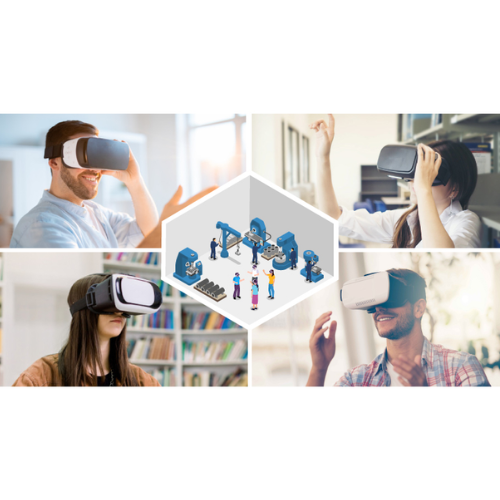Tech-Enabled Education
Technology has ushered in a new era in the education sector.
Technology has enabled students and teachers to elevate the level of learning by quantum leaps. For instance, Virtual Reality classrooms are a game-changer in facilitating higher education by fostering better engagement and conceptual understanding.
Knowledge dissemination is an in-class activity. However, its processing and absorption happen as an after-class activity. In the traditional system, a gap occurred as students could not clear their doubts after classes. This either dampened their enthusiasm or left their learning incomplete. Both do not bode well for higher education like medicine or engineering.
Technology has allowed learners to learn anywhere, anytime. With the help of AI tools, students can resolve their queries in real-time. As a matter of fact, there are AI tools that can also generate quizzes and question papers for students based on their content submissions. All this helps to sustain the learner’s interest as well as foster a higher learning index.
How can Virtual Reality be deployed in Higher Education?
Virtual reality labs has no longer a stranger to students and teachers that exists in the fantasy world of science fiction movies. It can be experienced right here in the classroom. Many reputed higher education facilities have deployed this novel technology to offer students an immersive learning experience. In fact, many educational institutes have realised that they need cutting-edge technology to match the learning needs of the next generation professions.
So whether they be scientists, engineers, doctors and entrepreneurs, lawyers or teachers, traditional methods are not coping with current needs. Let’s see how VR is bettering the higher educational landscape.
Promoting Active Learning
Lecture-based learning has been the traditional method of study. However, technology has allowed students to experience a better and more effective system based on Active Learning. It enhances skill development and knowledge.
As a matter of fact, Lecturio has reported the results of a study based on Lecture Based vs Active
Learning-based methods. The results show that undergraduate students in STEM courses like science, technology, engineering, and mathematics (STEM) courses exposed to lecture-based classes were 1.5 times more likely to fail their examinations than students who adopted active learning.
Take the example of students pursuing a career in medicine. Which method would enable a better outcome? Learning about the heart as an organ through a lecture and diagram on the board method? Or a student experiencing a 3D animated cross-sectional anatomical rendition of the heart?
Limitless Learning
The educational sector was entrenched in the notion that learning can only occur at specific locations. Moreover, if students were unable to attend classes due to geographical constraints, it meant the end of their career aspirations. However, technology has changed the dynamics. Now, learning can happen anywhere and at any time.
Moreover, it is not limited to geographical boundaries. The higher education universities rose to the challenge and embraced technology with open arms. What started with video conferencing and online meetings has now progressed to more sophisticated models.
For example, Virtual Reality Labs.
VR Labs allow students to access learning from anywhere and anytime. They offer simulated and highly immersive learning experiences. Moreover, they are safe, risk-free and very cost-effective. Students can perform experiments or practice surgeries repeatedly at no additional overhead. They can even meet up with peers and mentors, which enhances collaboration.
Exploratory Land Experiential Learning
Exploration and Experiential Learning inspire critical thinking and spark the inherent curiosity in students. This is very important to cultivate a scientific temperament. An attitude that observes and draws inferences logically is the foundation of science-based education.
VR-enabled classrooms to allow students to immerse themselves in an alternate reality where they can experience various places, situations, events, and even objects.
For example,
- Students can go on field trips and take a tour of the Moon, all from the comfort of the classroom.
- They can visit the great civilisations like the Egyptian and Indus Valley and understand the evolution of society.
- In VR classrooms, rather than understanding the periodic table from a chart or understanding the chemical nature of substances by reading about them, students can hold elements and view the structural changes from within.
- Students can view the anatomy of the human body in 3D from within and understand its intricacies that are impossible in traditional classrooms.
Market Overview of VR in Higher Education
Virtual reality has infused new life into education and made it relevant to the current requirements. With VR, lessons can be brought to life. The numbers are good and the growth is promising.
- Fortune Business indicates that the global VR Education market will reach USD 13,098.2 million by 2026.
The higher education ecosystem is most likely to steer the growth of VR-enabled classrooms. Its adoption will continue to rise and will complement the traditional teaching methods. Higher education institutes and universities can increase student engagement, and globally expand their reach while avoiding campus overcrowding through VR classrooms.
VR fills not only the academic gaps but also offers soft skills training. Moreover, it’s excellent for upskilling as well. Professionals like experienced doctors and engineers can enrol in VR upskilling at their comfort and convenience to get additional practice if required.
To conclude, the Virtual Reality Classroom offers seamless and immersive learning opportunities. It allows students to prepare, become workforce ready, and improve their skills in a risk-free zone. It is cost-effective and result-oriented. The dual benefits of time and locational convenience, along with a high level of immersive learning, is unsurpassed.

